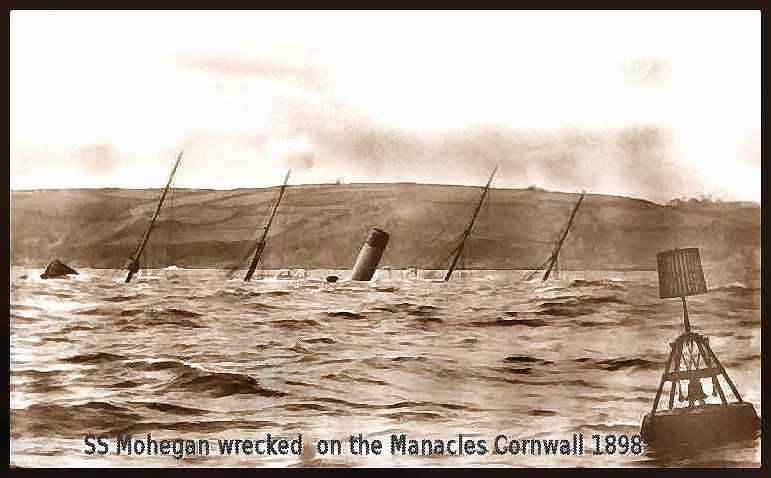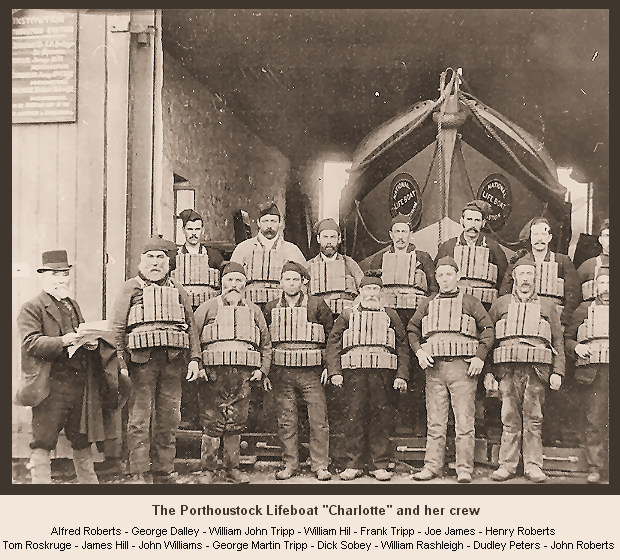The Shipwreck of The Mohegan
- taped memories 1966

In October 1966 a tape recording was
made of interviews with three St. Keverne people who
had either witnessed the tragedy or who had heard
first hand accounts of it within their families over
many years.
Joe Rogers was born in Rosenithon in October
1893 and was five years old at the time of the
disaster. Some of his recollections are his own,
others are from members of his family who were
personally involved both during and after the events
of 14 October 1898.
Joe, as a child, remembered being disturbed by the
rocket which was fired from Tommy Noye's field
above Porthoustock because the noise reverberated to
such an extent that the windows rattled. His sister,
Dora, heard screams from the front steps of the
Rogers family home in Rosenithon, while his mother
and Janie Tripp went off to Porthoustock to help.
They were the first two women on the scene.
Next morning Joe was taken to the shore by his father
and he vividly remembered seeing the Mohegan's
four masts and red funnel sticking up above the
water.
Joe's grandfather, William Matthews, and his
great uncle, Captain John Matthews, both of
Porthoustock, saw a man jump off the prow of the
Porthoustock lifeboat as it grounded on to the beach
and disappear up through the village and up the
valley.
Tradition has it that this was Captain Griffiths of
the Mohegan and substantiated the story that the
vessel had been deliberately wrecked.
Joe recalled that four survivors stayed with his
grandparents at Porthoustock, including the boy John
(Jimmy) MacFarlane who was best remembered for his
swearing and for playing the mouth organ. He had two
broken legs and was at Porthoustock for about six
months.
Joe was out with his father the day after the wreck
and they found a body washed ashore which they took
by cart to St. Keverne. He recalled the story of Miss
Noble who stayed at Rosenithon with the Rogers family
after the loss of the Mohegan, Miss Noble commented
to Joe's parents about the chaos on board because
the lights went out on the Mohegan so soon after
striking the Manacles.
The second person interviewed was Bentley
Tripp who was born in 1901, the son of George
Martin Tripp and Ellen Jane (nee Peters).
Bentley had been brought up on stories of shipwrecks
and the sea as his father was a fisherman and a
lifeboat crew member at Porthoustock.
Bentley himself was a fisherman with first hand
experience of the coastal waters off St.Keverne and
he knew the Manacles "like the back of his
hand".
Bentley recalled that, from the story told to him by
his father, the Mohegan appeared from the east into
Falmouth Bay and looked like a floating town because
of all the lights. However, she then turned and took
a course straight for the Manacles.
His father, George Martin Tripp, was a stroke-oarsman
in the Porthoustock lifeboat and on the evening of 14
October 1898 the sea was moderating with a heavy
swell. When the "Charlotte" was about half
way to the Manacles by Maen Garrick (the rocks due
east of Manacle Point) it came across an upturned
lifeboat from the Mohegan. One (or two) people were
rescued from the keel, but, according to
Bentley's version, there were twenty four people
dead underneath it. They went on in darkness towards
the cries and screams coming from the vicinity of the
Manacles and came across the second Mohegan lifeboat.
George Tripp had told Bentley that there was one
young lady about 28 or 29 in a Mohegan lifeboat. She
had long hair which had become entangled with ropes
at the bottom of the lifeboat. Frank Tripp, a crew
member of the "Charlotte" who was "a
good man on land and sea" took an axe and cut
her hair to free her. (Ed. This is a very similar
account to that of the rescue of Mrs.Compton Swift
except that in the other version she had been trapped
by her foot). However, when Frank Tripp was using the
axe to cut her hair, the "Charlotte" rolled
and the axe blade struck the leg of another passenger
and badly cut it. The result of this unfortunate
incident is that the other passenger who had been
rescued, Mrs. Lizzie Small Grandin, bled to death in
the Porthoustock lifeboat before she could be landed.
This story ties in with the known fact that Mrs.
Grandin died in the Porthoustock lifeboat before it
reached Porthoustock beach.

Bentley's mother, Janie Tripp, and Mrs.
Margaret Ann Rogers had rushed to Porthoustock as
soon as the rocket had been fired and witnessed the
scene on the shore. They remembered the distress on
the beach as the lifeboat landed because families had
been split up and members were missing. The local
doctor, Dr. Spry, was rendering help to the victims
and asked Janie Tripp to escort two elderly male
survivors up to a cottage in Porthoustock village
but, en route, in the darkness she took fright and
returned to the beach.
Bentley recalled that the next morning bodies from
the wreck came ashore on all the beaches between
Lowlands and Godrevy and that they were carried in
farm carts up to St. Keverne village. The bodies were
laid out in the church, although some of the more
affluent Americans were embalmed and taken back to
the USA. A firm of embalmers came from London to St.
Keverne as embalming was not carried out by any local
firm of undertakers.
He remembered that his father had said that,after the
"Charlotte" had landed on Porthoustock
beach, a person dressed in brown fireman's
overalls jumped off the side and ran up through
Porthoustock village as "if fired from a
gun".
Next morning a man was seen taking a boat and rowing
across the Helford River. Was this person Captain
Griffiths? Rumour had it that he knew the area well
and had deliberately lost the ship in order to get,
as a shareholder of the Atlantic Transport Company,
the full insurance. However, if Captain Griffiths had
local knowledge, why did he run the Mohegan on to the
Vase Rock when he could have run her inside the
Voices or on to the Lowlands without any loss of
life?
The last person to be interviewed on the tape in
October 1966 was George Lory of St. Keverne,
the village carpenter and undertaker. He had been
born at Trevalso in 1881 and was 18 at the time of
the disaster. He recalled the story of how Mrs.
Grandin had died in the Porthoustock lifeboat as a
result of "having her leg cut off"
accidentally by Frank Tripp's axe. He, too,
believed that the Mohegan had been wrecked
deliberately. He referred to the embalming of some of
the bodies in the house where St. Keverne garage now
stands and supported the tradition that Captain
Griffiths had been rescued and then disappeared.
George told how the last body was picked up some
seven or eight weeks after the disaster.
He recounted that there had been a lot of ale on
board the Mohegan and that some of this was washed
ashore. This ale was of good quality and was enjoyed
by the locals, Mr. Lory included.
St Keverne Local History Society is grateful to
Mrs Collen Rogers for permission to reproduce these
recordings. To listen to all of the tapes
![]() click here
click here